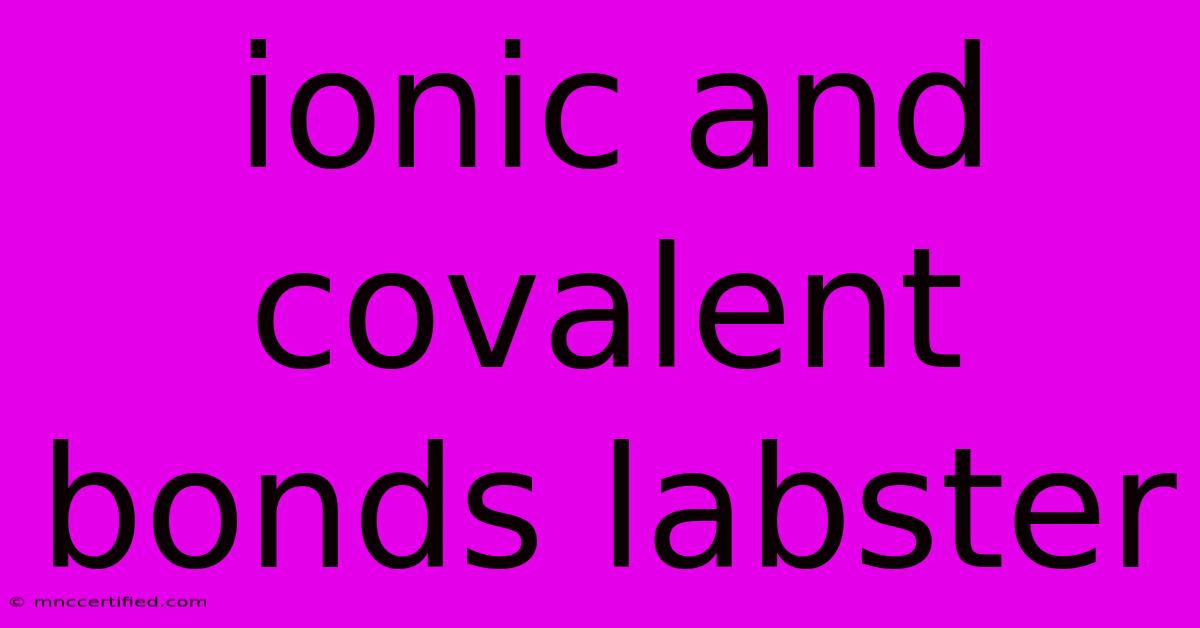Ionic And Covalent Bonds Labster

Table of Contents
Ionic and Covalent Bonds: A Deep Dive with Labster
Understanding ionic and covalent bonds is fundamental to grasping chemistry. This article will explore these crucial concepts, focusing on how Labster's virtual simulations enhance learning and provide a deeper understanding than traditional textbook study. We'll cover key differences, examples, and how to best utilize Labster's resources to master this topic.
What are Ionic and Covalent Bonds?
Chemical bonds are the forces that hold atoms together to form molecules and compounds. There are several types of bonds, but two prominent ones are:
Ionic Bonds: The Dance of Opposite Charges
Ionic bonds are formed through the electrostatic attraction between oppositely charged ions. This happens when one atom donates an electron (or more) to another atom. The atom that loses electrons becomes a positively charged cation, while the atom that gains electrons becomes a negatively charged anion. The strong attraction between these ions creates the ionic bond.
Key characteristics of ionic bonds:
- High melting and boiling points: Due to the strong electrostatic forces.
- Crystalline structure: Ions arrange themselves in a regular, repeating pattern.
- Conduct electricity when dissolved in water or molten: Because the ions are free to move.
- Often formed between metals and nonmetals: Metals tend to lose electrons, while nonmetals tend to gain them.
Example: Sodium chloride (NaCl), common table salt, is a classic example. Sodium (Na) loses one electron to become Na+, and chlorine (Cl) gains one electron to become Cl-. The electrostatic attraction between Na+ and Cl- forms the ionic bond.
Covalent Bonds: Sharing is Caring
Covalent bonds form when two atoms share one or more pairs of electrons. This sharing creates a stable outer electron shell for both atoms, satisfying the octet rule (except for Hydrogen which only needs 2 electrons).
Key characteristics of covalent bonds:
- Lower melting and boiling points than ionic bonds: The forces holding the atoms together are weaker.
- Often exist as gases, liquids, or low-melting solids: Reflecting their weaker intermolecular forces.
- Generally do not conduct electricity: Because there are no free-moving charges.
- Often formed between nonmetals: Nonmetals tend to share electrons rather than completely transferring them.
Example: Water (H₂O) is a prime example. Each hydrogen atom shares one electron with the oxygen atom, forming two covalent bonds.
Labster: Enhancing Your Understanding of Ionic and Covalent Bonds
Labster's interactive simulations offer a unique and engaging way to learn about ionic and covalent bonds. Unlike passively reading a textbook, Labster allows you to:
- Visualize the bond formation: Observe the electron transfer in ionic bonds and electron sharing in covalent bonds in a dynamic, 3D environment.
- Conduct virtual experiments: Perform experiments that would be difficult or impossible to perform in a real lab, like manipulating atoms and observing the changes in bonding.
- Test your knowledge: Answer interactive questions and quizzes to reinforce your learning.
- Explore real-world applications: Learn how ionic and covalent bonds relate to everyday materials and phenomena.
Using Labster Effectively
To maximize the benefits of Labster's ionic and covalent bonds simulations, consider the following:
- Familiarize yourself with the simulation interface: Take some time to understand the controls and navigation before starting the experiment.
- Follow the instructions carefully: Pay attention to the steps and instructions provided within the simulation.
- Take notes: Jot down important observations and conclusions.
- Repeat the simulation: Re-running the simulation can strengthen your understanding and help solidify concepts.
- Connect with the learning objectives: Understand what specific concepts Labster is targeting to focus your attention appropriately.
Beyond the Labster Simulation
While Labster provides an invaluable learning experience, it's crucial to supplement it with additional resources. Review your textbook, consult reputable online resources, and discuss the concepts with classmates or instructors. This combined approach will ensure a comprehensive understanding of ionic and covalent bonds.
Conclusion
Ionic and covalent bonds are foundational concepts in chemistry. Labster offers a powerful tool to learn and visualize these complex processes, but combining Labster's interactive simulations with traditional study methods is key to achieving a deep and lasting understanding of chemical bonding. By actively engaging with the simulations and complementing your learning with other resources, you can build a strong foundation in chemistry and excel in your studies.

Thank you for visiting our website wich cover about Ionic And Covalent Bonds Labster. We hope the information provided has been useful to you. Feel free to contact us if you have any questions or need further assistance. See you next time and dont miss to bookmark.
Featured Posts
-
Mendota Insurance Payment Online
Nov 21, 2024
-
20 35 An Hour Is How Much A Year
Nov 21, 2024
-
How To Find The Next 100x Crypto
Nov 21, 2024
-
Cheap Car Insurance In Conroe Tx
Nov 21, 2024
-
Tim Parkman Insurance Clinton Ms
Nov 21, 2024